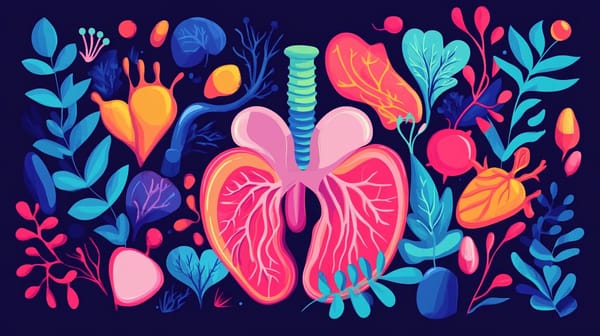Are you feeling stressed, isolated, or just plain down? Did you know that a hormone in your body is responsible for increasing positivity and reducing feelings of anxiety? Enter oxytocin: the "love hormone". This powerful neurotransmitter plays a crucial role in promoting bonding, boosting mood, improving social skills, and even speeding up wound healing. Don't fret if it sounds too technical! Our bodies naturally produce this wonder-hormone and with the right habits in place, you can boost your oxytocin arsenal effectively. Buckle up as we unpack 10 easy tweaks to your routine that can spark your brain to release more oxytocin. It's all here; no lab coats required, just a dose of natural feel-good science!
This article provides a comprehensive guide on various natural methods to increase oxytocin levels in the body. Techniques such as exercise, music, touch, and activities like massage or cuddling have been found to boost oxytocin production. Additionally, we explore the potential impact of nutrition, gut health, and certain lifestyle choices on oxytocin levels. While individual results may vary, incorporating these strategies into your life may help promote feelings of well-being and social connection.


The Role of Physical Touch
Physical touch, such as cuddling, hugging, and massage, has been found to increase the release of oxytocin in the body. This fact is due to the role that this hormone plays in promoting bonding and social behaviors. Oxytocin levels are stimulated through physical contact by the activation of mechanoreceptors that trigger the hypothalamus to release oxytocin into circulation throughout the bloodstream. As a result, research has shown that touch can have a significant calming effect on individuals, reducing stress and anxiety levels by decreasing cortisol production.
Consider the last time you hugged or cuddled someone - perhaps it was a family member or friend. Didn't it feel fantastic? That's probably because your brain was flooded with oxytocin, making you feel good and improving your emotional well-being.
Cuddling and Hugging
Cuddling and hugging are two of the most natural ways to boost your body's oxytocin levels. Research confirms that this age-old practice isn't just great for emotional comfort; it also releases various feel-good hormones like dopamine, endorphins, and serotonin levels into your bloodstream.
Cuddling even includes other intrapersonal benefits as well. It helps disengage one from any surrounding worries and creates connections with others through non-verbal communication such as eye contact, gentle touches, and holding limbs. Being physically close helps take us back to a feeling of security we once felt in childhood when parents would hold us tight or stroke our heads when we needed comfort.
But how does one incorporate cuddling into their daily routine?
Simple ways would be cuddling with pets, sleeping together with a loved one during bedtime and giving hugs to friends and family every now and then. For example, talking through a difficult situation while holding hands or embracing can foster a sense of safety while building bonds that led researchers to believe that we have evolved to touch one another to strengthen social bonds and reinforce emotional wellbeing.
Benefits of Massage
Massage has been shown to be an effective way to increase levels of oxytocin in the body. Research suggests that deep tissue massages, reflexology and Swedish massages are associated with higher levels of oxytocin release. Massage is a popular option for those looking to decrease stress, anxiety and depression while increasing feelings of relaxation and overall wellness. When combined with other natural methods of boosting oxytocin levels, such as touch and exercise, massage can be a powerful way to improve mood and promote overall well-being.
Imagine having a long day at work or feeling sore after a strenuous workout; getting a massage can help relieve pain and take away stress from everyday life. Added to that, you get the added benefit of boosting your oxytocin levels, which promotes even greater feelings of relaxation.
Emotional State and Oxytocin
Oxytocin is often referred to as the “love hormone” due to its role in promoting positive emotional bonding. It's the reason why we feel closer to our significant others after cuddling or hugging. Interestingly, even imagining romantic love stories triggers the release of oxytocin in the brain and increases feelings of warmth and affection.
On the opposite spectrum, low oxytocin levels are linked to negative emotions such as loneliness and social anxiety. This phenomenon helps link how increased oxytocin through certain exercises like yoga or mindful meditation reduces feelings of stress, anxiety, and depression.
However, it's worth noting that too much oxytocin can also have negative effects on one's behavior, leading to increased aggression towards outgroup members. Thus, balance in production is needed when aiming for higher levels.

Now that we have understood the importance of emotions in relation to oxytocin production, let's move onto some simple mental exercises you could integrate into your daily routine to boost your levels of this powerful hormone.
- Studies indicate that physical touch, such as hugging or massaging, can increase oxytocin levels by up to 27%.
- Listening to music, particularly in a group setting, has been shown to boost oxytocin levels by 9% to 28%, according to a study published in Frontiers in Psychology in 2016.
- Owning pets, especially dogs, is linked with an increase of up to 300% in oxytocin levels, as found by a study from the University of Japan in 2009.
Positive Mental Exercises
Our thoughts and emotions have a significant impact on our physical body's overall health and well-being. Hence, part of the process of increasing oxytocin levels involves engaging in positive mental exercises that help reduce stress, anxiety, and depression. Meditation and mindfulness are excellent examples of positive mental exercises that can increase oxytocin levels. Studies show that practicing meditation can help regulate the levels of cortisol (the stress hormone) in our bodies, resulting in a more relaxed state.
Another approach to incorporate positivity into your life is by practicing gratitude daily. By developing a habit of focusing on what we're grateful for, we narrow down our attention to things that bring us joy, leading to increased happiness.
Social Interaction and Its Effects
Social interaction is one of the most effective ways to boost oxytocin levels naturally as it typically involves activities such as hugging, cuddling, or kissing that encourage physical contact with others. Interactions with pets could also lead to an increase in oxytocin as they provide similar benefits. As humans, we're wired for social interaction, and dopamine and oxytocin are part of the feel-good hormones released in these situations.
One example of how socializing with others can boost oxytocin levels:
| Activity | Description |
|---|---|
| Volunteering | A sense of connection towards a common goal can elevate oxytocin |
| Group Dinners | Sharing food among friends releases dopamine and creates a sense of community |
| Group Fitness Classes | Working out in groups has multiple benefits like motivation, accountability & produces endorphins |
However, social interaction might not work for everyone. People dealing with social anxiety might find it challenging to engage socially due to fear or discomfort. In such cases, seeking professional guidance or gradually exposing oneself to social situations may be helpful.
While positive mental exercises and social interactions are powerful ways to increase oxytocin levels, simple lifestyle changes could benefit us too. Let's explore some of these changes.
Lifestyle Changes for Oxytocin Boost
Oxytocin is essential for our overall well-being and plays an important role in social bonding, trust, and relaxation. Fortunately, there are simple ways to enhance oxytocin production in the body without resorting to drugs or other artificial means. In this section, we'll explore various lifestyle changes you can make to improve your oxytocin levels.
One of the most effective methods of boosting oxytocin is through physical touch. This could be through hugging a loved one, cuddling with your partner, or even getting a massage. Such physical touch enhances the release of oxytocin and helps reduce anxiety.
Apart from these physical contact methods that help release oxytocin into the bloodstream, lifestyle changes like getting enough sleep and reducing stress also stimulate oxytocin secretion. Practicing mindfulness meditation is another way to boost your oxytocin levels while also increasing resilience in stressful situations.
| Lifestyle Changes For Oxytocin Boost |
|---|
| Physical Touch (e.g., hugging, cuddling) |
| Meditation |
| Getting sufficient sleep |
Exercise and Diet
Exercise has been shown to facilitate the release of endorphins, which are famous as "feel-good" chemicals. Engaging in high-intensity martial arts training boosts oxytocin levels naturally; join a local boxing club or try cycling up steep hills to get those endorphins going. Group singing has also proven to increase oxytocin levels; so belt out a tune with friends!
When it comes to diet, certain food groups promote natural increases in oxytocin production; foods such as chocolate and strawberries contain phenylethylamine which promotes dopamine release- another "feel-good" hormone produced by our brain. Eating foods rich in zinc such as chickpeas or oysters are proven to promote stable hormone levels in your body.
However, researchers and health professionals caution that there's a limited amount of data linking diet changes with increased oxytocin levels beyond the relationship between zinc and hormone stability. As a result,it is important to experiment to see what boosts your natural physiological level.
Consider eating more fruits and vegetables high in vitamins C & D and omega-3 fats that boost serotonin levels--another neurotransmitter linked to mood regulation. Serotonin is produced in the gut so even taking probiotics that improve to replace bad bacteria in the gut can help regulate serotonin and thereby oxytocin levels as well. Cutting out sugar, alcohol, dairy, wheat or gluten from your diet can also help reduce inflammation, one of the main causes of imbalanced mood.
Intimacy and its Influence on Oxytocin
Intimacy is a complex concept that encompasses physical, emotional, and psychological closeness between individuals. It can occur in different forms such as hugging, cuddling, kissing, or sexual activity. Regardless of the form intimacy takes, it can have a significant impact on oxytocin levels in the human body.
When we experience intimate moments with someone we love or care about, our brains release oxytocin. This hormone plays a critical role in building trust, fostering attachment, and encouraging social relationships. For instance, it promotes the mother-baby bond during breastfeeding and stimulates uterine contractions during labor.
Picture this scenario- you're cuddled up on the couch with your significant other while watching a romantic movie. As the film progresses, you begin to feel increasingly relaxed and comfortable in their embrace. That's because physical touch leads to an increase in oxytocin levels, producing feelings of well-being and comfort.
Research has shown that various intimate activities can lead to a substantial boost in oxytocin levels:
| Activity | Increase In Oxytocin Levels |
|---|---|
| Snuggling/Cuddling | 25% |
| Hugging | 47% |
| Kissing | 52% |
| Sexual intercourse | Up to 400% |
| Erogenous zone stimulation | Up to 273% |
| Orgasm | Up to 522% |
Think of it as building a house - intimacy is like laying down the foundation for strong bonds that will last through challenges. Just like how bricks come together to form a strong structure, small moments of intimacy could build up to meaningful relationships.
However, it's essential to note that not all types of intimacy involve physical touch. Emotional intimacy, such as feeling heard, seen, and valued by a partner or a close friend can also trigger oxytocin production. Sharing vulnerabilities or positive experiences with someone you trust can be equally important in building and nurturing relationships.
While the benefits of intimacy on oxytocin levels are undeniable, it's crucial to acknowledge that everybody is different. Many people experience difficulty when it comes to seeking out intimate moments with others. Whether it's due to past trauma, cultural factors, or personal inhibitions, individuals should not feel forced into engaging in activities they are not comfortable with.
Through all of this, we hope to have emphasized the importance of intimacy in increasing oxytocin levels in the body. Remember, small steps taken towards nurturing healthy relationships could lead to long-term improvements in social bonds and personal well-being.
- Intimacy, whether physical or emotional, can have a significant impact on oxytocin levels in the body. Oxytocin plays a crucial role in building trust, fostering attachment, and promoting social relationships. Activities like snuggling, hugging, kissing, sexual intercourse, and orgasm can lead to substantial increases in oxytocin levels. Emotional intimacy, such as feeling heard and valued by a partner or friend, also triggers oxytocin production. However, it's important to respect individual boundaries and preferences when it comes to intimacy. Small moments of intimacy can build strong bonds and contribute to overall well-being.






